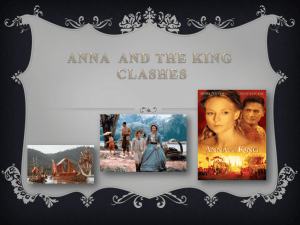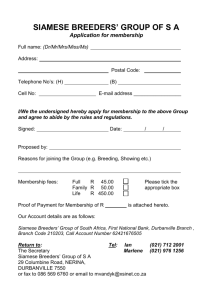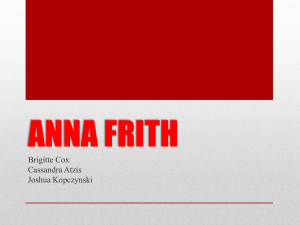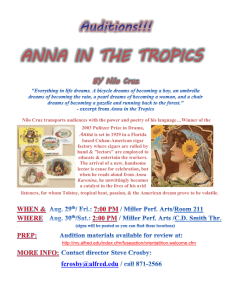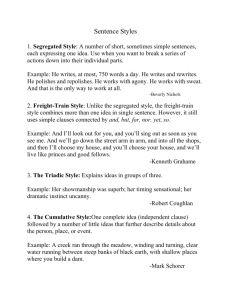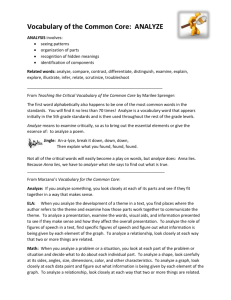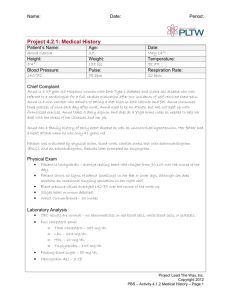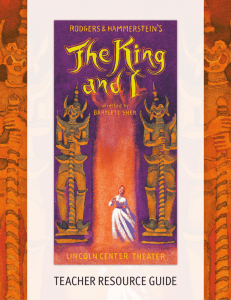The King and I Study Guide - Abilene Christian University
advertisement
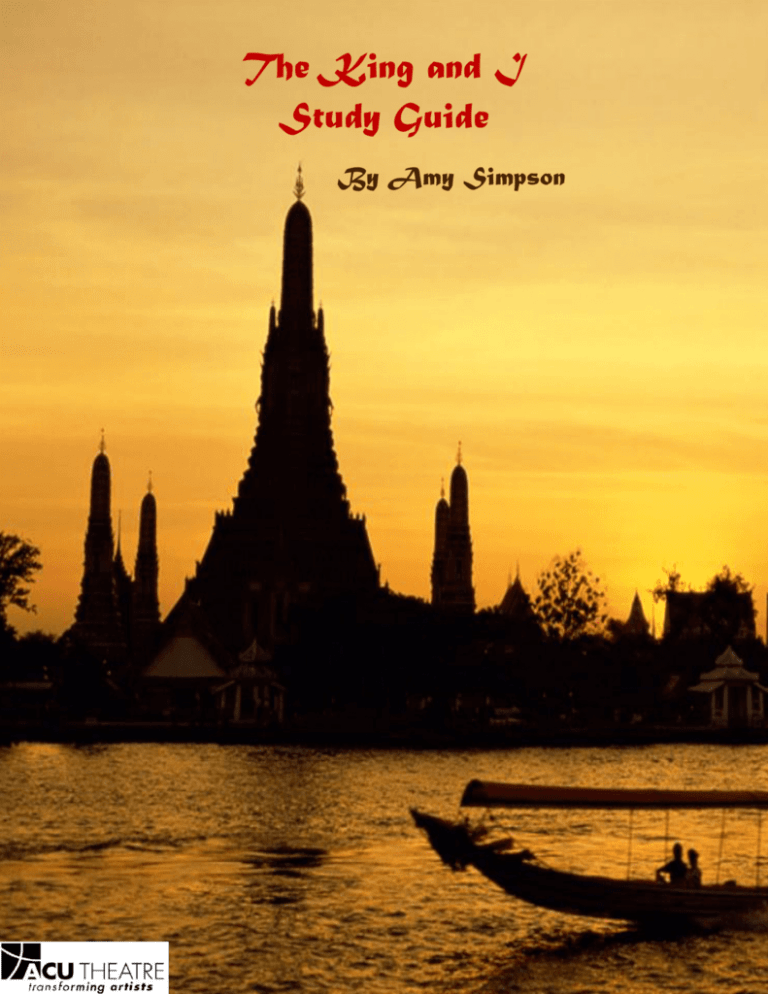
The King and I Study Guide By Amy Simpson Contents The King and I as Musical The King and I as Film The King and I as Fact Reflections of Culture Reflections of History Reflections in Art Reflections in Theatre Works Cited Page The King and I As Musical The King and I was first produced on Broadway in 1952. It was written by the famous musical writing team Richard Rodgers and Oscar Hammerstein: 3 2 In 1952, The King and I won the Tony Awards for Best Musical, Best Actress, Best Featured Actor, Best Scenic and Costume Design. The King and I As Film 4 You may be most familiar with the 1956 film starring Deborah Kerr and Yul Brynner. That film was nominated for 9 Academy Awards, and won 5 of them. 5 The King and I As Fact You may not know that the musical is based on the True Story of a woman named Anna Leonowens who spent time as the Royal Governess at King Mongkut’s Siamese Court. The King and I (and any other “Anna” story) is based upon her memoirs of her time in Siam. 6 7 When Anna arrived in Siam… She found it to be a beautiful, exotic place. 8 The economy was good, the government powerful and there was a very clear social class system with the king at the very top. There were those who had money and talent and those who did not. Both were important to Siamese society and both were caused, the Siamese Buddhists believe, by Karma. 9 Most of those living in Siam were Buddhists who believe that human beings can live many different lives, being born over and over again as different people or creatures. If they help others and remove desire in their hearts, they achieve good Karma and will have less suffering and more success and peace in their next life. An important aspect of the Buddhist religion is the Reverence due to White Animals… 10 White animals like the dove, swan, stork or monkey are said to house the Souls of Noble, Pure and Good Humans. 11 The White Elephant is the Greatest, said to carry the Soul of a King or Hero. Since he has the wisdom of a great man, the white elephant can signal national good fortune, success and peace. 12 13 Whenever one is found, a huge Celebration is declared throughout the land to honor the elephant and offer Thanksgiving for the Blessings such a creatures is said to bring. When Anna arrived in Siam, she knew some things about Southeast Asian culture and language. She lived in numerous Southeast Asian and Indian cities including Singapore where she learned to speak Malay – a language she was able to use even in Siam. Siam Singapore 14 Imperialism… Anna also knew a lot about Southeast Asia because her home country England and many other European countries had Imperialistic Tendencies, which lead them to believe that they could Capture and Rule other countries as their own. Imperialism… The British Empire colonized India, and then they took cities the Spanish had claimed in the Philippines, and the French colonized Vietnam and Cambodia. Siam Philippines Vietnam India Cambodia 14 Many Europeans in Siam were interested only in money. They were there because it was profitable to be there. The state of affairs [in England], however, was complex and far from stable. The old mercantile Empire was weakened during the late eighteenth and early nineteenth centuries by a number of factors: by the abolition in 1807 of slavery in Britain itself, a movement led by the Evangelicals ; by the freeing in 1833 of slaves held elsewhere in the Empire; by the adoption, after a radical change in economic perspective (due in large part to the influence of Adam Smith's The Wealth of Nations), of Free Trade, which minimized the influence of the old oligarchical and monopolistic trading corporations; and by various colonial movements for greater political and commercial independence.15 Imperialism… Victorians justified their imperialistic actions with the thoughts of British Prime Minister Benjamin Disraeli and of Charles Darwin. 16 17 Disraeli said those in the East loved being a small part of the great British Empire -- that it was a privilege for them. Social Darwinism used the idea of The Survival of the Fittest to claim that there were certain people who were innately meant to rule over others and certain people who were innately meant to serve and do manual labor. Obviously, in the eyes of the Europeans, they were meant to rule and the Asians were meant to serve. King Mongkut did not want to be seen as a barbarian who was meant to serve. He believed it was very important to Engage these Western countries on their own terms. In 1855 (just 7 years before Anna came to his court) King Mongkut signed the Bowring Treaty, which opened Siam up to trading both goods and ideas with 12 European countries including England. 18 The repercussions of the treaty Changed rules and context for a lot of Siamese Business and Cultural Traditions: exports grew, making Ports Busier, Property Rights became more defined, Capitalist Ideas grew while the Power of the Nobles Waned. Not everyone was happy with King Mongkut for signing the Bowring Treaty. But he was a thoughtful man and did what he believed was best for his country. King Mongkut was thoughtful in part because he spent over Twenty-Five Years in political exile as a Buddhist Monk in a monastery. 19 He spoke many different languages, including English; which he learned from English-speaking missionaries and he read all the time. However, he was a staunch Buddhists and was not afraid to express both his respect and distaste for Christianity. In 1851, after his political enemy died, he was brought out of exile and declared King of Siam. As King, Anna Leonowens describes him as both a Caring, Enlightened, and Virtuous Ruler and as a Terrifying Tyrant, especially with his family: he expressed great 7 Jealousy, Anger, and Favoritism with his wives and their children. The women in the palace had little say about what they did and when they did it. Indeed, Anna describes the life of a wife or concubine as life in a Gilded Cage, where “light and darkness are monstrously mixed”19. 20 In all things – in all things -- they are bound to the will of the king. Anna tells one story of one woman who petitioned the king that a position “held by her late uncle…might be bestowed on her elder brother”. She did not know, however, that King Mongkut preferred another man for the position. When the king received her petition, he had her Captured, Flogged, Beaten, and Chained to the Wall in a Muddy, Rotting, Prison. Once Anna brought the woman’s plight to the attention of the king’s court, his conscience returned and he released the woman to return to her only son. Yet, this example shows why the Women in the Palace were so Fearful and Careful. Reflections on Culture… Clearly nineteenth century Siam was an exciting place to be: on the brink between Western and Easter philosophies; enjoying Social Independence and Wealth, yet aware of possible takeover by Imperialistic Europeans; the citizens saw a movement towards Greater Democracy and a Balance of Power in the land yet still Feared for Their Lives if they spoke against the King; Women were often treated little better than Carnal Slaves, yet a woman was hired to the Respected Position of Teacher that other women might Learn and Grow. Do you see any contradictions in our own society? What are they? Reflections in History… The following list includes words and names of people that fit into an historically imperialistic category. Pick a Partner. Then, pick one name, word or phrase. Create a 10 minute presentation about how this phrase or person impacted British Imperialism. You must including important dates, at least one image, and at least one quote from a book or an online article. Sir James Lancaster General George Campbell of Inverneill CB., Esquire Benjamin Disraeli Queen Victoria Imperialism The British East India Company The 1857 Indian Mutiny John Jacob Thomas John A. Hobson Thomas Babington Macaulay The East India Company Acts The Government of India Acts Social Darwinism Herbert Spencer and Survival of the Fittest Rudyard Kipling and The White Man’s Burden Reflections in Art… Imagine what it must have been like to live within the Siamese Palace walls. It would have been very different if you were a woman, a guard, a child or the crowned prince. Imagine that you are one of those people. Using the art tools your teacher gives you, create a visual art piece that reflects what life would be like living in that group: Reflections in Theatre… Imagine that you have been cast as a chorus member in The King and I. You must come up with accurate background movement for the following scenes: 1. The opening scene on the boat 2. The scene where the wives are getting ready for the Europeans to visit What do you choose to do, and why? Do you work independently or with others? Are you happy about what you’re going, or are you sad, or scared, or tired or upset? As you practice this background movement, make sure it starts before you even step on stage: image what your character is doing throughout the day and especially right before they walk on stage. Imagine you are cast as Chulalongkorn or as Louis. How do you create a believable child on stage? What do you remember from your childhood and early teenage years that could help you as you create this character? As a Theatre Artist, it’s important to know why we do certain theatre pieces. Should we choose a piece because it provides the audience with a means of escape? How about choosing a piece because it enlightens or educates the audience, or because it challenges social mores? Would you direct, act in or design a set for The King and I? Why or why not? Works Cited Page… 1. Cover Image: Provider: Luxotic World Website: http://luxoticworld.com/tag/thailand Date Obtained: 08/25/2011 2. Provider: applause online.com Website: http://www.applauseonline.com/images/King~I~OBP.jpg Date Obtained: 08/25/2011 3. Provider: TalkMoviesworld.com Website: http://movies.broadwayworld.com/article/Rodgers_Hammerstein_Organization_Launches_Podca st_Series_20090219 Date Obtained: Sept. 22, 2011 4. Provider: Moveedo Website: http://moveedo.com/movie/53657 Date Obtained: 08/25/2011 5. Website: http://pizzadominoes.com/oscar-night-pizza-time Date Obtained: Sept. 22, 2011 6. Website: http://www.hasekamp.net/anna.htm Date Obtained: 08/25/2011 7. Providor: Siamese Visions, blog Website: http://siamesevisions.blogspot.com/search/label/King%20Mongkut Date Obtained: 25 September 2011 8. Provider: Property World.com Website: http://www.propertyworld.com/Thailand Date Obtained: 8/25/2011 9. Provider: Esemplastic thermoplastic Website: http://drzubkov.com/cardinal-knowledge/philosophy/buddhist-philosophy/ Date Obtained: 08/28/2011 10. Website: http://gallery.craftech.com/linvilla/album_001/Animals_White+Dove.JPG.html Date Obtained: 23 September 2011 11. Provider: A LIE AND A TRUTH Website: http://alieandatruth.blogspot.com/2009/09/colour-me-white.html Date Obtained: 23 September 2011 12. Website: http://www.123rf.com/photo_2056857_tiny-white-elephant-statues.html Date Obtained: 08/08/2011 13. http://siamesevisions.blogspot.com/search/label/Elephants Date Obtained: 08/08/2011 14. Provider: Perry-Castañeda Library Map Collection, University of Texas Date created: 1892 Location: Asia License: This work is believed to be in the public domain. Users are advised to make their own copyright assessment and to understand their rights to fair use. Website: http://www.learnnc.org/lp/multimedia/3280 Date Obtained: 08/08/2011 15. C o d y , D a v i d . " T h e B r i t i s h E m p i r e . " V i c t o r i a n W e b . n . p a g e . W e b . 2 6 S e p . 2011. <http://www.saylor.org/site/wp -content/uploads/2011/04/The British-Empire.pdf>. Date Obtained: 23 September 2011 16. H Lenthall Benjamin Disraeli, 1st Earl of Beaconsfield (1804-1881) 19th Cen Painting Provider: Vangobot Website: http://popartmachine.com/item/pop_art/FASF-FASF.305201/H-LENTHALL-BENJAMINDISRAELI,-1ST-EARL-OF-BEACONSFIELD-(1804-1881)-19TH-CEN Date Obtained: 23 September 2011 17. © From the Richard Milner Archive Provider: GreatScience.com Website: http://www.glsc.org/darwin/darwin_press.php Date Obtained: 23 September 2011 18. Provider: dipity Website: http://www.dipity.com/jakehollin/US-History-Timeline-Pink/ Date Obtained: 25 September 2011 19. L e o n o w e n s , A n n a n n a . T h e E n g l i s h G o v e r n e s s A t T h e S i a m e s e C o u r t . Kessinger Publishing, 2010. 74. Print. 20. Providor: Siamese Visions, blog Website: http://siamesevisions.blogspot.com/search/label/King%20Mongkut Date Obtained: 25 September 2011 Books: Englehart, Neil A. Culture and Power in Traditional Siamese Government . 1st ed. 18. Ithaca: Cornell University, 2011. Print. Leonowens, Anna. The English Governess At The Siamese Court . Kessinger Publishing, 2010. Print.
